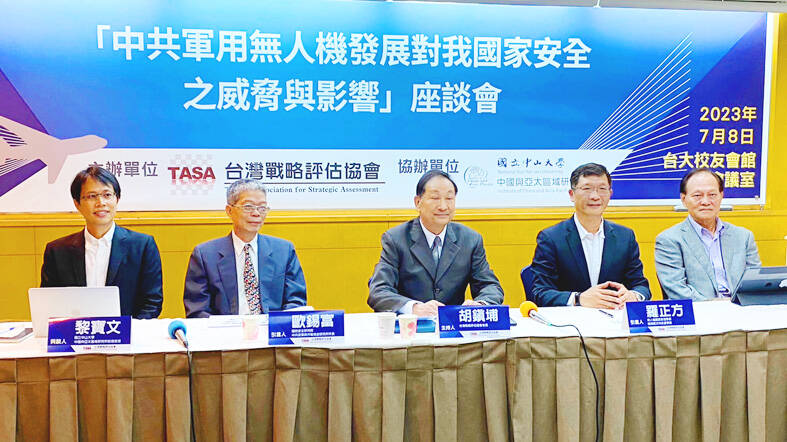If China were to invade Taiwan, it would likely attack by mainly using drones, which have become the face of modern warfare due to their low cost, high efficiency and ability to minimize casualties, former army commander-in-chief general Hu Chen-pu (胡鎮埔) said yesterday.
Hu, head of the Taiwan Association for Strategic Assessment, made the remarks at a seminar hosted by the association in Taipei that addressed the threats to Taiwan’s security posed by Chinese military drones.
The ongoing war between Ukraine and Russia has put drones at the forefront of modern warfare, Hu said.

Photo: CNA
China has been developing drones at a fast pace in the past few years, and has amassed numerous military drones, which it began using to circle Taiwan a few months ago, he said, adding that the drones that China flew around Taiwan all had combat and reconnaissance capabilities.
Noting that drones are relatively low cost, highly efficient and do not cause any casualties to the user’s side, Hu said that if China were to invade Taiwan, drones would be its primary weapons of choice.
Ou Si-fu (歐錫富), a research fellow at the Institute for National Defense and Security Research, said China has been regularly employing drones in its military activities since September last year.
The models it has typically used have included ASN drones used by the Chinese People’s Liberation (PLA) and Army Rocket Force, the BZK-005 drone used by the navy, the GJ-1 and WZ-7 drones used by the air force, and the JWP-02 drones used by the Army Rocket Force, he added.
Drones have surveillance, reconnaissance, deception and strike capabilities, and have become ubiquitous in modern warfare, he said.
As China is not part of the Missile Technology Control Regime, it has established itself as a major drone supplier, which is something the world should pay close attention to, he said.
Drones have been widely incorporated in combat beyond the range of target acquisition, hence the nickname “eyes in the sky,” Lo Cheng-fang (羅正方), CEO of Geosat Aerospace & Technology Inc said at the seminar.
Drones with combat and reconnaissance capabilities are to be the focus of Taiwan’s domestic drone development over the next five years, he said.
The Chien Hsiang anti-radiation loitering munitions developed by the state-run weapons developer Chungshan Institute of Science and Technology would be a formidable deterrence in electronic warfare, he added.

Eight restaurants in Taiwan yesterday secured a one-star rating from the Michelin Guide Taiwan for the first time, while three one-star restaurants from last year’s edition were promoted to two stars. Forty-three restaurants were awarded one star this year, including 34 in Taipei, five in Taichung and four in Kaohsiung. Hosu (好嶼), Chuan Ya (川雅), Sushi Kajin (鮨嘉仁), aMaze (心宴), La Vie by Thomas Buhner, Yuan Yi (元一) and Frassi in Taipei and Front House (方蒔) in Kaohsiung received a one-star rating for the first time. Hosu is known for innovative Taiwanese dishes, while Chuan Ya serves Sichuan cuisine and aMaze specializes

Taitung County is to launch charter flights to Malaysia at the end of this year, after setting up flights to Vietnam and Thailand, the Taitung County Government said yesterday. The new charter flight services, provided by low-cost carrier Batik Air Malaysia, would be part of five-day tour packages for visits to Taitung County or Malaysia. The Batik Air charter flight, with about 200 seats, would take Malaysian tourists to Taitung on Dec. 30 and then at 12:35pm return to Kuala Lumpur with Taiwanese tourists. Another charter flight would bring the Taiwanese home on Jan. 3 next year, arriving at 5:30pm, before taking the

Taiwan High Speed Rail Corp. (THSRC) plans to ease strained capacity during peak hours by introducing new fare rules restricting passengers traveling without reserved seats in 2026, company Chairman Shih Che (史哲) said Wednesday. THSRC needs to tackle its capacity issue because there have been several occasions where passengers holding tickets with reserved seats did not make it onto their train in stations packed with individuals traveling without a reserved seat, Shih told reporters in a joint interview in Taipei. Non-reserved seats allow travelers maximum flexibility, but it has led to issues relating to quality of service and safety concerns, especially during

An exhibition celebrating Taiwan and Japan’s comic culture opened on Saturday in Taichung, featuring a section that explores Taiwanese reproductions of Japanese comics from when martial law limited Japanese representation. “A Century of Manga Culture: An Encounter of Taiwan and Japan’s Youth” held its Taiwan opening ceremony at Taichung’s National Taiwan Museum of Comics after an initial one-month run in Japan’s Kyoto International Manga Museum between May 24 and June 24. Much like the Kyoto exhibition, the show mainly celebrates the comic connection between Taiwan and Japan through late Taiwanese comic book